The Role of Pay Secrecy in Human Resource Management Strategies
VerifiedAdded on 2023/01/13
|6
|1908
|60
Essay
AI Summary
This essay explores pay secrecy as a significant component of business strategy within the realm of human resource management. It defines pay secrecy as a policy that restricts employees from discussing their compensation, examining its potential impact on employee efficiency, productivity, and career decisions. The essay argues that pay secrecy can be beneficial by preventing perceptions of unfairness, mitigating workplace conflicts, and protecting employee privacy. It delves into the arguments for and against pay secrecy, including its effects on employee mobility, market inefficiency, and organizational control. The analysis highlights how pay secrecy can influence employee behavior, facilitate conflict resolution, and impact an organization's ability to retain competent employees. The essay concludes by emphasizing the importance of pay secrecy in modern human resource management, particularly in the context of technologically driven surveillance and its implications for business strategies. The work also provides a comprehensive overview of the cited research, including the analysis of pay secrecy's impact on employee morale, justice perceptions, and organizational commitment.
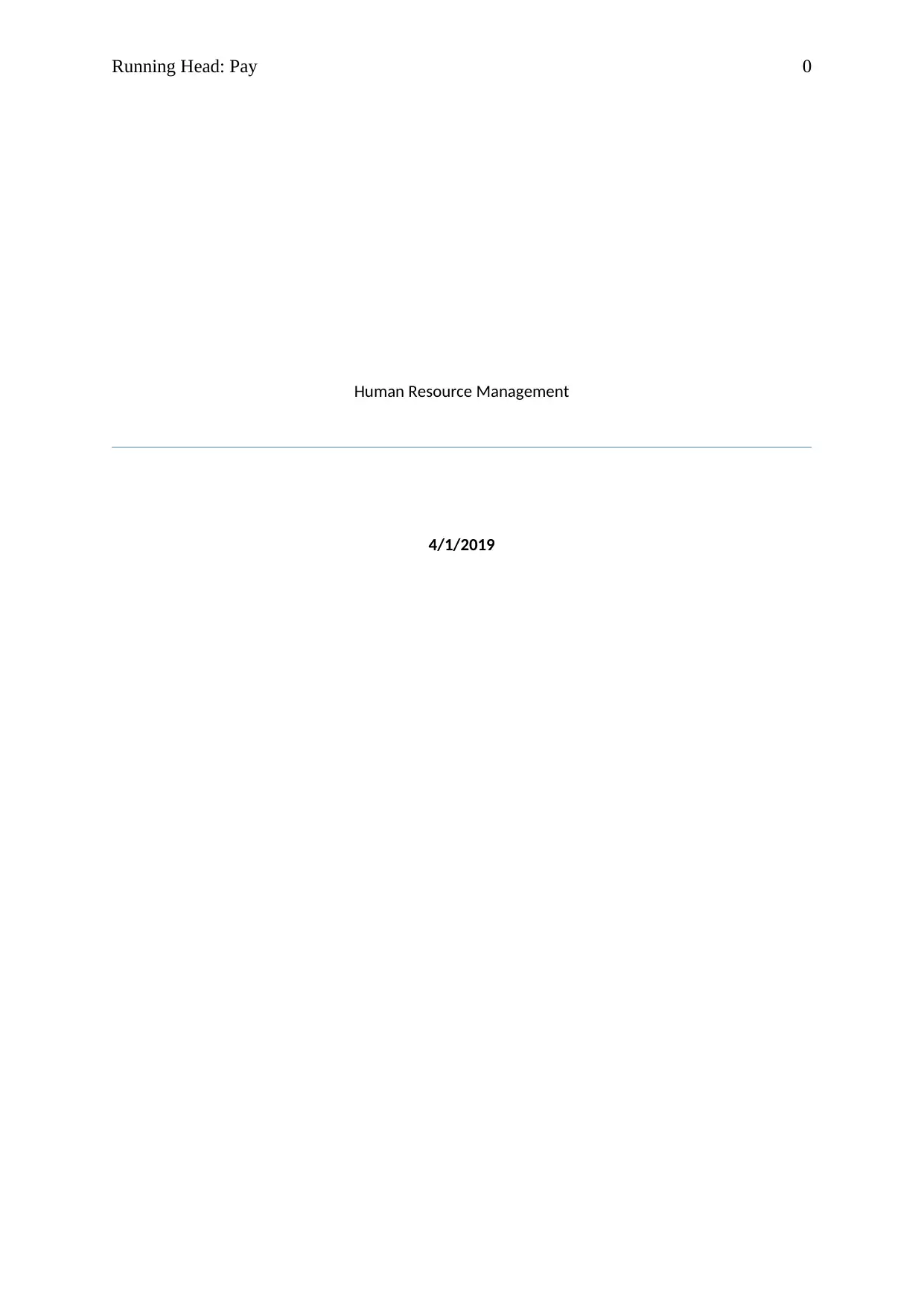
Running Head: Pay 0
Human Resource Management
4/1/2019
Human Resource Management
4/1/2019
Paraphrase This Document
Need a fresh take? Get an instant paraphrase of this document with our AI Paraphraser
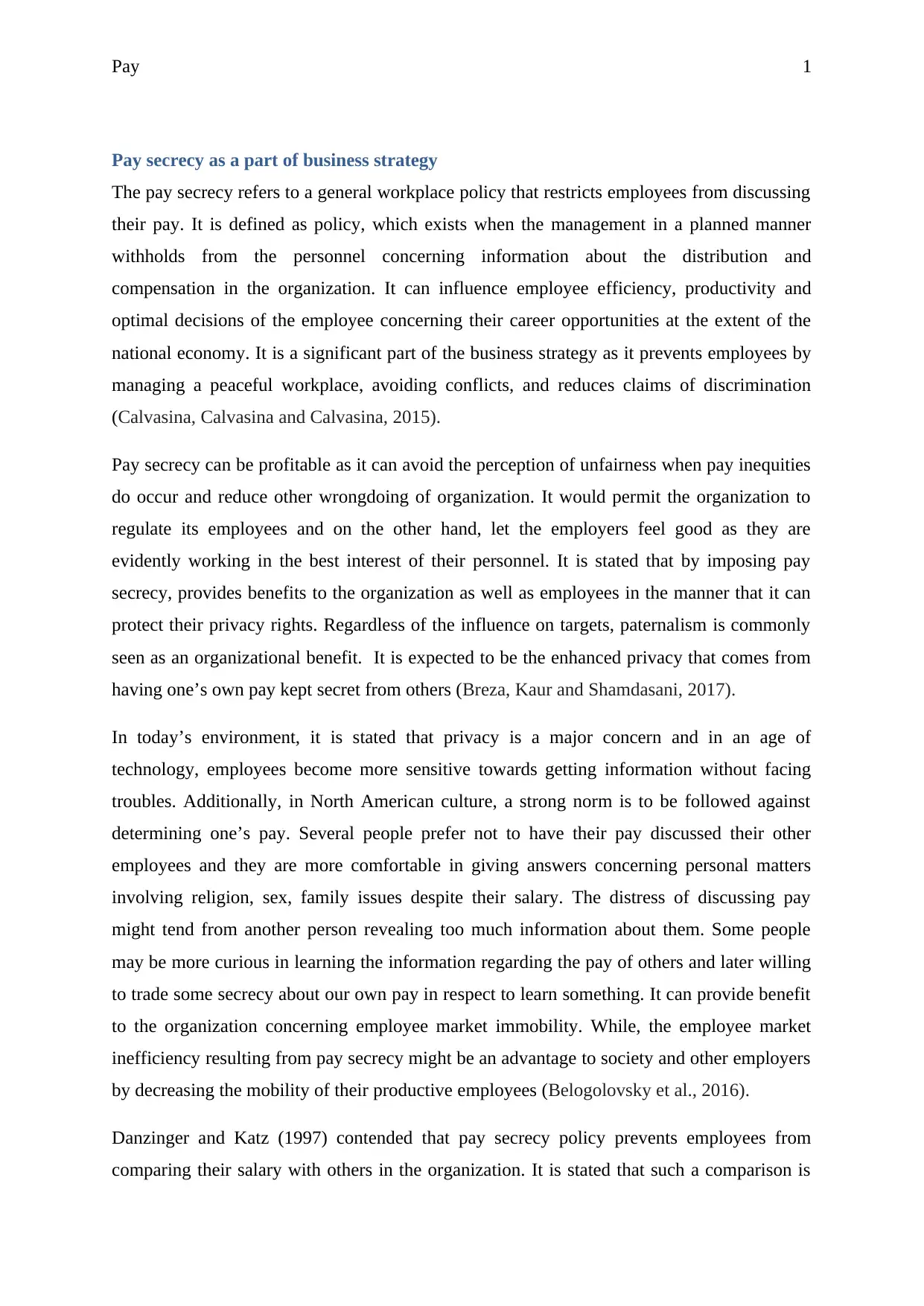
Pay 1
Pay secrecy as a part of business strategy
The pay secrecy refers to a general workplace policy that restricts employees from discussing
their pay. It is defined as policy, which exists when the management in a planned manner
withholds from the personnel concerning information about the distribution and
compensation in the organization. It can influence employee efficiency, productivity and
optimal decisions of the employee concerning their career opportunities at the extent of the
national economy. It is a significant part of the business strategy as it prevents employees by
managing a peaceful workplace, avoiding conflicts, and reduces claims of discrimination
(Calvasina, Calvasina and Calvasina, 2015).
Pay secrecy can be profitable as it can avoid the perception of unfairness when pay inequities
do occur and reduce other wrongdoing of organization. It would permit the organization to
regulate its employees and on the other hand, let the employers feel good as they are
evidently working in the best interest of their personnel. It is stated that by imposing pay
secrecy, provides benefits to the organization as well as employees in the manner that it can
protect their privacy rights. Regardless of the influence on targets, paternalism is commonly
seen as an organizational benefit. It is expected to be the enhanced privacy that comes from
having one’s own pay kept secret from others (Breza, Kaur and Shamdasani, 2017).
In today’s environment, it is stated that privacy is a major concern and in an age of
technology, employees become more sensitive towards getting information without facing
troubles. Additionally, in North American culture, a strong norm is to be followed against
determining one’s pay. Several people prefer not to have their pay discussed their other
employees and they are more comfortable in giving answers concerning personal matters
involving religion, sex, family issues despite their salary. The distress of discussing pay
might tend from another person revealing too much information about them. Some people
may be more curious in learning the information regarding the pay of others and later willing
to trade some secrecy about our own pay in respect to learn something. It can provide benefit
to the organization concerning employee market immobility. While, the employee market
inefficiency resulting from pay secrecy might be an advantage to society and other employers
by decreasing the mobility of their productive employees (Belogolovsky et al., 2016).
Danzinger and Katz (1997) contended that pay secrecy policy prevents employees from
comparing their salary with others in the organization. It is stated that such a comparison is
Pay secrecy as a part of business strategy
The pay secrecy refers to a general workplace policy that restricts employees from discussing
their pay. It is defined as policy, which exists when the management in a planned manner
withholds from the personnel concerning information about the distribution and
compensation in the organization. It can influence employee efficiency, productivity and
optimal decisions of the employee concerning their career opportunities at the extent of the
national economy. It is a significant part of the business strategy as it prevents employees by
managing a peaceful workplace, avoiding conflicts, and reduces claims of discrimination
(Calvasina, Calvasina and Calvasina, 2015).
Pay secrecy can be profitable as it can avoid the perception of unfairness when pay inequities
do occur and reduce other wrongdoing of organization. It would permit the organization to
regulate its employees and on the other hand, let the employers feel good as they are
evidently working in the best interest of their personnel. It is stated that by imposing pay
secrecy, provides benefits to the organization as well as employees in the manner that it can
protect their privacy rights. Regardless of the influence on targets, paternalism is commonly
seen as an organizational benefit. It is expected to be the enhanced privacy that comes from
having one’s own pay kept secret from others (Breza, Kaur and Shamdasani, 2017).
In today’s environment, it is stated that privacy is a major concern and in an age of
technology, employees become more sensitive towards getting information without facing
troubles. Additionally, in North American culture, a strong norm is to be followed against
determining one’s pay. Several people prefer not to have their pay discussed their other
employees and they are more comfortable in giving answers concerning personal matters
involving religion, sex, family issues despite their salary. The distress of discussing pay
might tend from another person revealing too much information about them. Some people
may be more curious in learning the information regarding the pay of others and later willing
to trade some secrecy about our own pay in respect to learn something. It can provide benefit
to the organization concerning employee market immobility. While, the employee market
inefficiency resulting from pay secrecy might be an advantage to society and other employers
by decreasing the mobility of their productive employees (Belogolovsky et al., 2016).
Danzinger and Katz (1997) contended that pay secrecy policy prevents employees from
comparing their salary with others in the organization. It is stated that such a comparison is
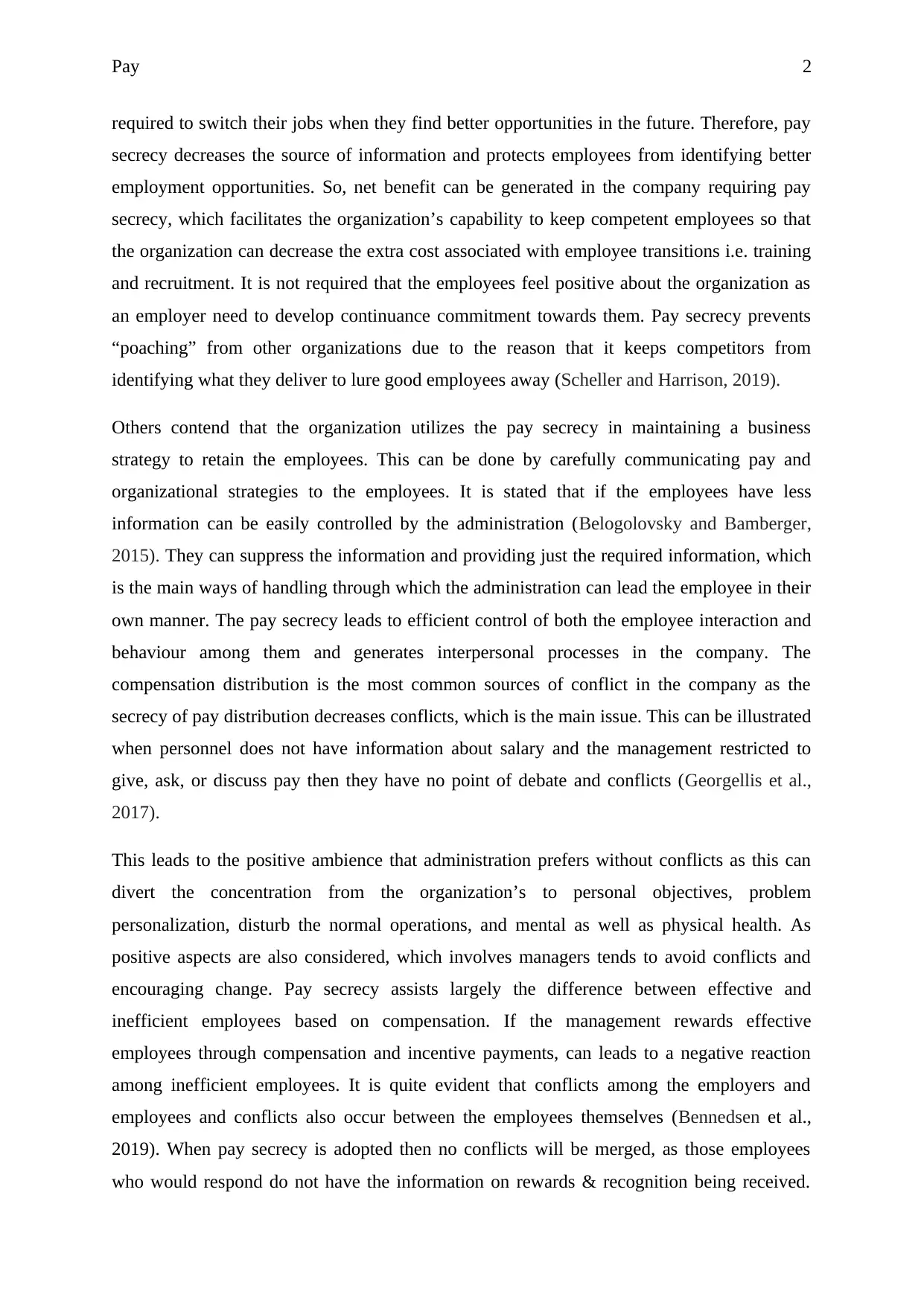
Pay 2
required to switch their jobs when they find better opportunities in the future. Therefore, pay
secrecy decreases the source of information and protects employees from identifying better
employment opportunities. So, net benefit can be generated in the company requiring pay
secrecy, which facilitates the organization’s capability to keep competent employees so that
the organization can decrease the extra cost associated with employee transitions i.e. training
and recruitment. It is not required that the employees feel positive about the organization as
an employer need to develop continuance commitment towards them. Pay secrecy prevents
“poaching” from other organizations due to the reason that it keeps competitors from
identifying what they deliver to lure good employees away (Scheller and Harrison, 2019).
Others contend that the organization utilizes the pay secrecy in maintaining a business
strategy to retain the employees. This can be done by carefully communicating pay and
organizational strategies to the employees. It is stated that if the employees have less
information can be easily controlled by the administration (Belogolovsky and Bamberger,
2015). They can suppress the information and providing just the required information, which
is the main ways of handling through which the administration can lead the employee in their
own manner. The pay secrecy leads to efficient control of both the employee interaction and
behaviour among them and generates interpersonal processes in the company. The
compensation distribution is the most common sources of conflict in the company as the
secrecy of pay distribution decreases conflicts, which is the main issue. This can be illustrated
when personnel does not have information about salary and the management restricted to
give, ask, or discuss pay then they have no point of debate and conflicts (Georgellis et al.,
2017).
This leads to the positive ambience that administration prefers without conflicts as this can
divert the concentration from the organization’s to personal objectives, problem
personalization, disturb the normal operations, and mental as well as physical health. As
positive aspects are also considered, which involves managers tends to avoid conflicts and
encouraging change. Pay secrecy assists largely the difference between effective and
inefficient employees based on compensation. If the management rewards effective
employees through compensation and incentive payments, can leads to a negative reaction
among inefficient employees. It is quite evident that conflicts among the employers and
employees and conflicts also occur between the employees themselves (Bennedsen et al.,
2019). When pay secrecy is adopted then no conflicts will be merged, as those employees
who would respond do not have the information on rewards & recognition being received.
required to switch their jobs when they find better opportunities in the future. Therefore, pay
secrecy decreases the source of information and protects employees from identifying better
employment opportunities. So, net benefit can be generated in the company requiring pay
secrecy, which facilitates the organization’s capability to keep competent employees so that
the organization can decrease the extra cost associated with employee transitions i.e. training
and recruitment. It is not required that the employees feel positive about the organization as
an employer need to develop continuance commitment towards them. Pay secrecy prevents
“poaching” from other organizations due to the reason that it keeps competitors from
identifying what they deliver to lure good employees away (Scheller and Harrison, 2019).
Others contend that the organization utilizes the pay secrecy in maintaining a business
strategy to retain the employees. This can be done by carefully communicating pay and
organizational strategies to the employees. It is stated that if the employees have less
information can be easily controlled by the administration (Belogolovsky and Bamberger,
2015). They can suppress the information and providing just the required information, which
is the main ways of handling through which the administration can lead the employee in their
own manner. The pay secrecy leads to efficient control of both the employee interaction and
behaviour among them and generates interpersonal processes in the company. The
compensation distribution is the most common sources of conflict in the company as the
secrecy of pay distribution decreases conflicts, which is the main issue. This can be illustrated
when personnel does not have information about salary and the management restricted to
give, ask, or discuss pay then they have no point of debate and conflicts (Georgellis et al.,
2017).
This leads to the positive ambience that administration prefers without conflicts as this can
divert the concentration from the organization’s to personal objectives, problem
personalization, disturb the normal operations, and mental as well as physical health. As
positive aspects are also considered, which involves managers tends to avoid conflicts and
encouraging change. Pay secrecy assists largely the difference between effective and
inefficient employees based on compensation. If the management rewards effective
employees through compensation and incentive payments, can leads to a negative reaction
among inefficient employees. It is quite evident that conflicts among the employers and
employees and conflicts also occur between the employees themselves (Bennedsen et al.,
2019). When pay secrecy is adopted then no conflicts will be merged, as those employees
who would respond do not have the information on rewards & recognition being received.
⊘ This is a preview!⊘
Do you want full access?
Subscribe today to unlock all pages.

Trusted by 1+ million students worldwide
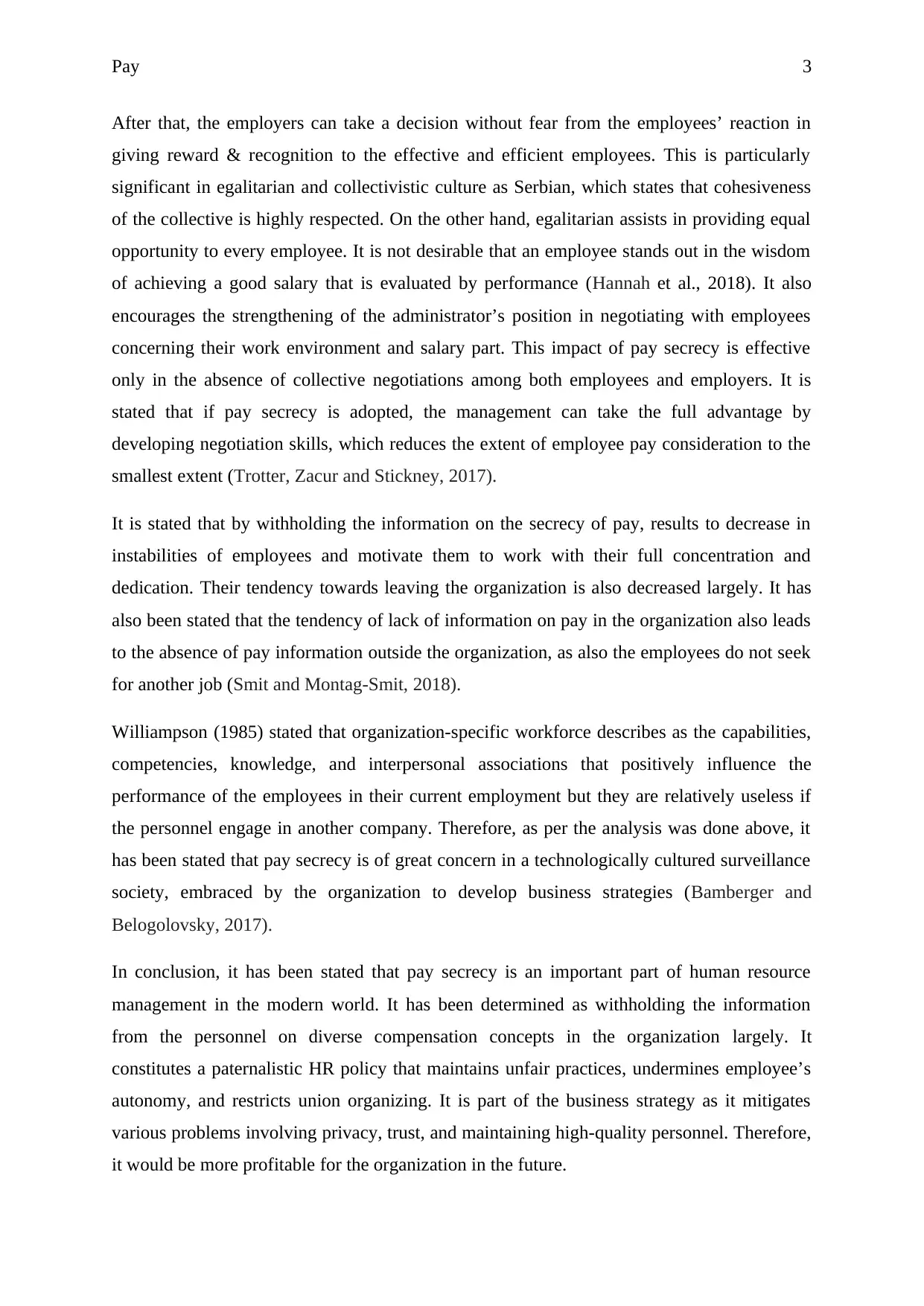
Pay 3
After that, the employers can take a decision without fear from the employees’ reaction in
giving reward & recognition to the effective and efficient employees. This is particularly
significant in egalitarian and collectivistic culture as Serbian, which states that cohesiveness
of the collective is highly respected. On the other hand, egalitarian assists in providing equal
opportunity to every employee. It is not desirable that an employee stands out in the wisdom
of achieving a good salary that is evaluated by performance (Hannah et al., 2018). It also
encourages the strengthening of the administrator’s position in negotiating with employees
concerning their work environment and salary part. This impact of pay secrecy is effective
only in the absence of collective negotiations among both employees and employers. It is
stated that if pay secrecy is adopted, the management can take the full advantage by
developing negotiation skills, which reduces the extent of employee pay consideration to the
smallest extent (Trotter, Zacur and Stickney, 2017).
It is stated that by withholding the information on the secrecy of pay, results to decrease in
instabilities of employees and motivate them to work with their full concentration and
dedication. Their tendency towards leaving the organization is also decreased largely. It has
also been stated that the tendency of lack of information on pay in the organization also leads
to the absence of pay information outside the organization, as also the employees do not seek
for another job (Smit and Montag‐Smit, 2018).
Williampson (1985) stated that organization-specific workforce describes as the capabilities,
competencies, knowledge, and interpersonal associations that positively influence the
performance of the employees in their current employment but they are relatively useless if
the personnel engage in another company. Therefore, as per the analysis was done above, it
has been stated that pay secrecy is of great concern in a technologically cultured surveillance
society, embraced by the organization to develop business strategies (Bamberger and
Belogolovsky, 2017).
In conclusion, it has been stated that pay secrecy is an important part of human resource
management in the modern world. It has been determined as withholding the information
from the personnel on diverse compensation concepts in the organization largely. It
constitutes a paternalistic HR policy that maintains unfair practices, undermines employee’s
autonomy, and restricts union organizing. It is part of the business strategy as it mitigates
various problems involving privacy, trust, and maintaining high-quality personnel. Therefore,
it would be more profitable for the organization in the future.
After that, the employers can take a decision without fear from the employees’ reaction in
giving reward & recognition to the effective and efficient employees. This is particularly
significant in egalitarian and collectivistic culture as Serbian, which states that cohesiveness
of the collective is highly respected. On the other hand, egalitarian assists in providing equal
opportunity to every employee. It is not desirable that an employee stands out in the wisdom
of achieving a good salary that is evaluated by performance (Hannah et al., 2018). It also
encourages the strengthening of the administrator’s position in negotiating with employees
concerning their work environment and salary part. This impact of pay secrecy is effective
only in the absence of collective negotiations among both employees and employers. It is
stated that if pay secrecy is adopted, the management can take the full advantage by
developing negotiation skills, which reduces the extent of employee pay consideration to the
smallest extent (Trotter, Zacur and Stickney, 2017).
It is stated that by withholding the information on the secrecy of pay, results to decrease in
instabilities of employees and motivate them to work with their full concentration and
dedication. Their tendency towards leaving the organization is also decreased largely. It has
also been stated that the tendency of lack of information on pay in the organization also leads
to the absence of pay information outside the organization, as also the employees do not seek
for another job (Smit and Montag‐Smit, 2018).
Williampson (1985) stated that organization-specific workforce describes as the capabilities,
competencies, knowledge, and interpersonal associations that positively influence the
performance of the employees in their current employment but they are relatively useless if
the personnel engage in another company. Therefore, as per the analysis was done above, it
has been stated that pay secrecy is of great concern in a technologically cultured surveillance
society, embraced by the organization to develop business strategies (Bamberger and
Belogolovsky, 2017).
In conclusion, it has been stated that pay secrecy is an important part of human resource
management in the modern world. It has been determined as withholding the information
from the personnel on diverse compensation concepts in the organization largely. It
constitutes a paternalistic HR policy that maintains unfair practices, undermines employee’s
autonomy, and restricts union organizing. It is part of the business strategy as it mitigates
various problems involving privacy, trust, and maintaining high-quality personnel. Therefore,
it would be more profitable for the organization in the future.
Paraphrase This Document
Need a fresh take? Get an instant paraphrase of this document with our AI Paraphraser
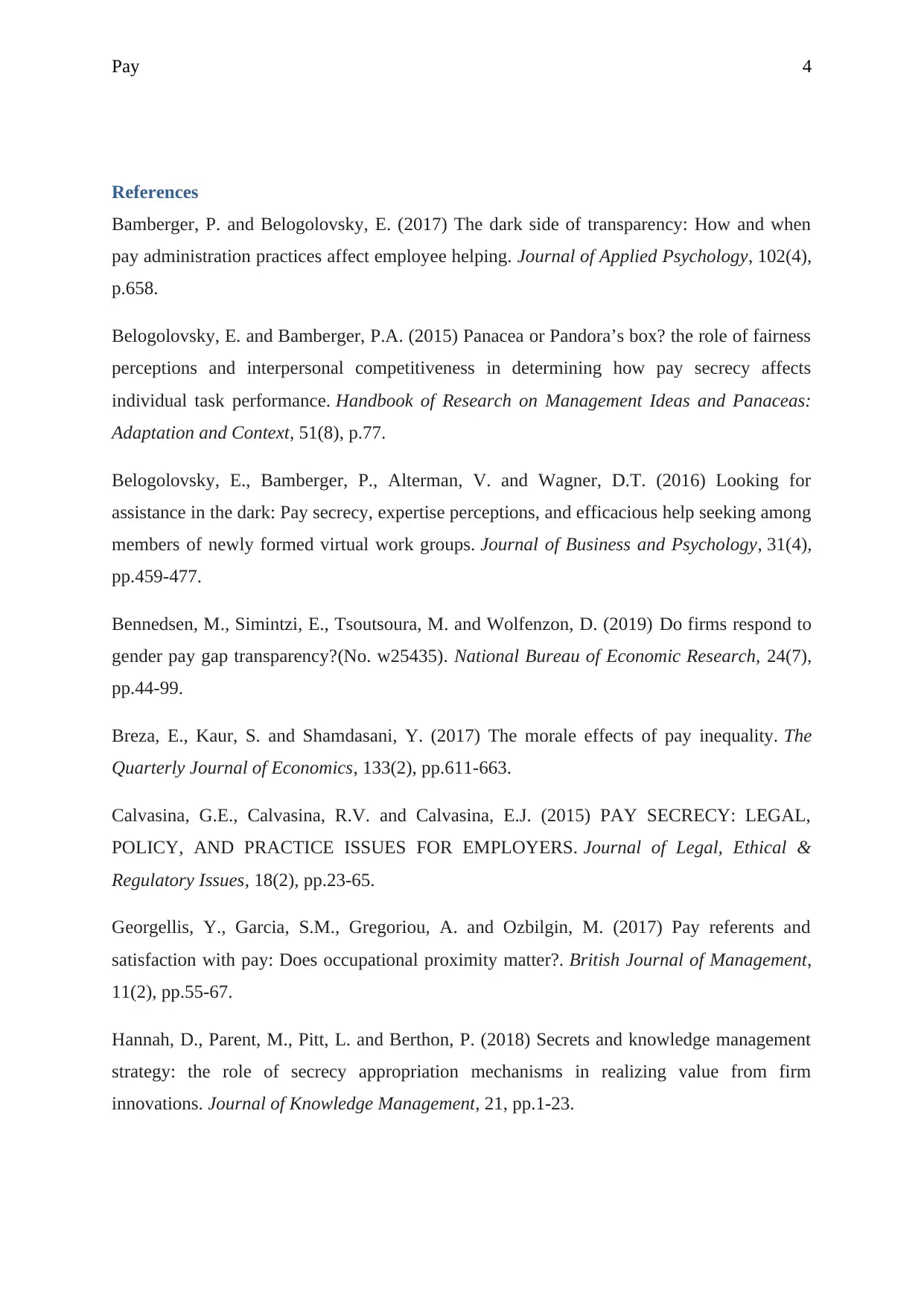
Pay 4
References
Bamberger, P. and Belogolovsky, E. (2017) The dark side of transparency: How and when
pay administration practices affect employee helping. Journal of Applied Psychology, 102(4),
p.658.
Belogolovsky, E. and Bamberger, P.A. (2015) Panacea or Pandora’s box? the role of fairness
perceptions and interpersonal competitiveness in determining how pay secrecy affects
individual task performance. Handbook of Research on Management Ideas and Panaceas:
Adaptation and Context, 51(8), p.77.
Belogolovsky, E., Bamberger, P., Alterman, V. and Wagner, D.T. (2016) Looking for
assistance in the dark: Pay secrecy, expertise perceptions, and efficacious help seeking among
members of newly formed virtual work groups. Journal of Business and Psychology, 31(4),
pp.459-477.
Bennedsen, M., Simintzi, E., Tsoutsoura, M. and Wolfenzon, D. (2019) Do firms respond to
gender pay gap transparency?(No. w25435). National Bureau of Economic Research, 24(7),
pp.44-99.
Breza, E., Kaur, S. and Shamdasani, Y. (2017) The morale effects of pay inequality. The
Quarterly Journal of Economics, 133(2), pp.611-663.
Calvasina, G.E., Calvasina, R.V. and Calvasina, E.J. (2015) PAY SECRECY: LEGAL,
POLICY, AND PRACTICE ISSUES FOR EMPLOYERS. Journal of Legal, Ethical &
Regulatory Issues, 18(2), pp.23-65.
Georgellis, Y., Garcia, S.M., Gregoriou, A. and Ozbilgin, M. (2017) Pay referents and
satisfaction with pay: Does occupational proximity matter?. British Journal of Management,
11(2), pp.55-67.
Hannah, D., Parent, M., Pitt, L. and Berthon, P. (2018) Secrets and knowledge management
strategy: the role of secrecy appropriation mechanisms in realizing value from firm
innovations. Journal of Knowledge Management, 21, pp.1-23.
References
Bamberger, P. and Belogolovsky, E. (2017) The dark side of transparency: How and when
pay administration practices affect employee helping. Journal of Applied Psychology, 102(4),
p.658.
Belogolovsky, E. and Bamberger, P.A. (2015) Panacea or Pandora’s box? the role of fairness
perceptions and interpersonal competitiveness in determining how pay secrecy affects
individual task performance. Handbook of Research on Management Ideas and Panaceas:
Adaptation and Context, 51(8), p.77.
Belogolovsky, E., Bamberger, P., Alterman, V. and Wagner, D.T. (2016) Looking for
assistance in the dark: Pay secrecy, expertise perceptions, and efficacious help seeking among
members of newly formed virtual work groups. Journal of Business and Psychology, 31(4),
pp.459-477.
Bennedsen, M., Simintzi, E., Tsoutsoura, M. and Wolfenzon, D. (2019) Do firms respond to
gender pay gap transparency?(No. w25435). National Bureau of Economic Research, 24(7),
pp.44-99.
Breza, E., Kaur, S. and Shamdasani, Y. (2017) The morale effects of pay inequality. The
Quarterly Journal of Economics, 133(2), pp.611-663.
Calvasina, G.E., Calvasina, R.V. and Calvasina, E.J. (2015) PAY SECRECY: LEGAL,
POLICY, AND PRACTICE ISSUES FOR EMPLOYERS. Journal of Legal, Ethical &
Regulatory Issues, 18(2), pp.23-65.
Georgellis, Y., Garcia, S.M., Gregoriou, A. and Ozbilgin, M. (2017) Pay referents and
satisfaction with pay: Does occupational proximity matter?. British Journal of Management,
11(2), pp.55-67.
Hannah, D., Parent, M., Pitt, L. and Berthon, P. (2018) Secrets and knowledge management
strategy: the role of secrecy appropriation mechanisms in realizing value from firm
innovations. Journal of Knowledge Management, 21, pp.1-23.
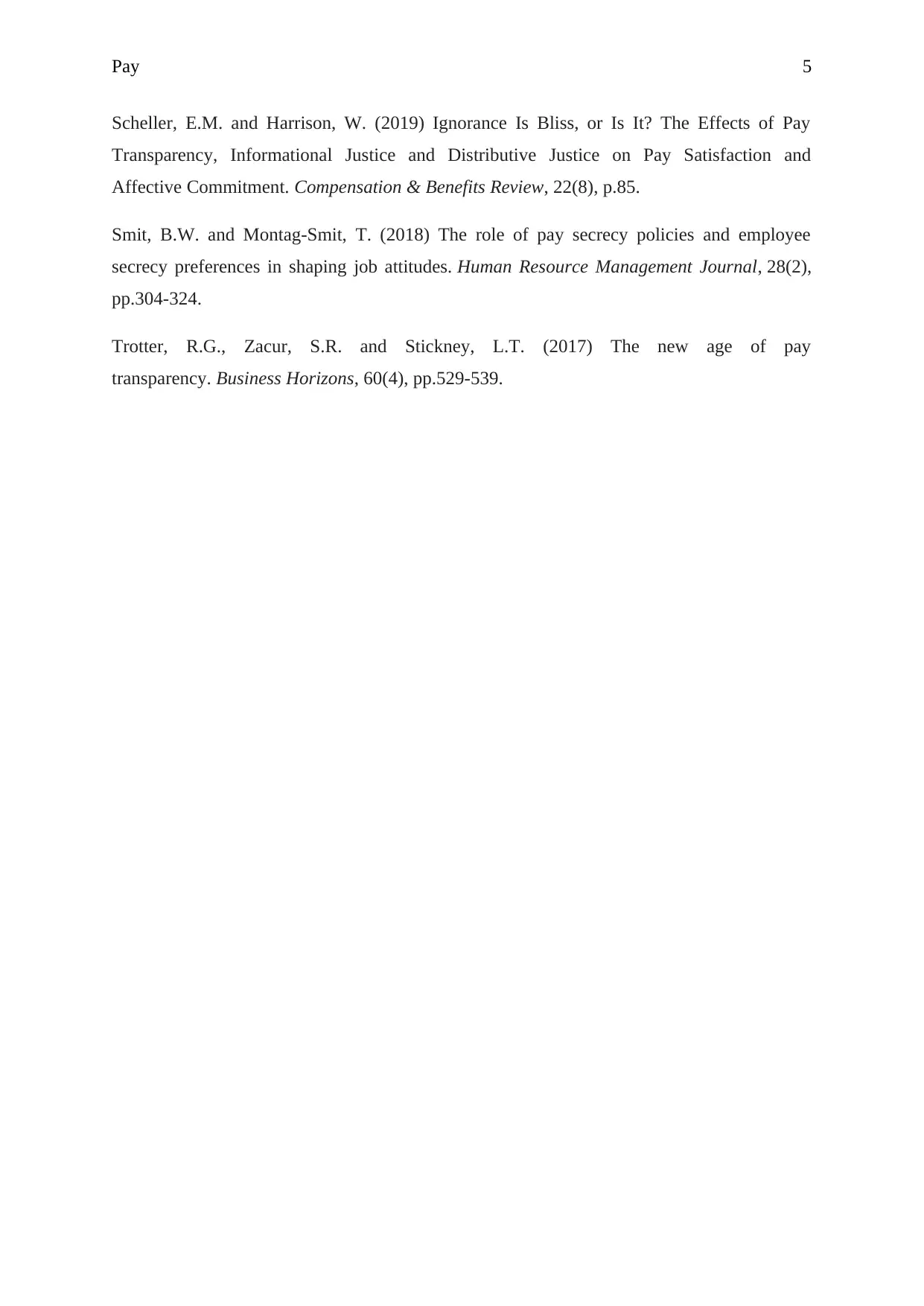
Pay 5
Scheller, E.M. and Harrison, W. (2019) Ignorance Is Bliss, or Is It? The Effects of Pay
Transparency, Informational Justice and Distributive Justice on Pay Satisfaction and
Affective Commitment. Compensation & Benefits Review, 22(8), p.85.
Smit, B.W. and Montag‐Smit, T. (2018) The role of pay secrecy policies and employee
secrecy preferences in shaping job attitudes. Human Resource Management Journal, 28(2),
pp.304-324.
Trotter, R.G., Zacur, S.R. and Stickney, L.T. (2017) The new age of pay
transparency. Business Horizons, 60(4), pp.529-539.
Scheller, E.M. and Harrison, W. (2019) Ignorance Is Bliss, or Is It? The Effects of Pay
Transparency, Informational Justice and Distributive Justice on Pay Satisfaction and
Affective Commitment. Compensation & Benefits Review, 22(8), p.85.
Smit, B.W. and Montag‐Smit, T. (2018) The role of pay secrecy policies and employee
secrecy preferences in shaping job attitudes. Human Resource Management Journal, 28(2),
pp.304-324.
Trotter, R.G., Zacur, S.R. and Stickney, L.T. (2017) The new age of pay
transparency. Business Horizons, 60(4), pp.529-539.
⊘ This is a preview!⊘
Do you want full access?
Subscribe today to unlock all pages.

Trusted by 1+ million students worldwide
1 out of 6
Related Documents
Your All-in-One AI-Powered Toolkit for Academic Success.
+13062052269
info@desklib.com
Available 24*7 on WhatsApp / Email
![[object Object]](/_next/static/media/star-bottom.7253800d.svg)
Unlock your academic potential
Copyright © 2020–2025 A2Z Services. All Rights Reserved. Developed and managed by ZUCOL.





